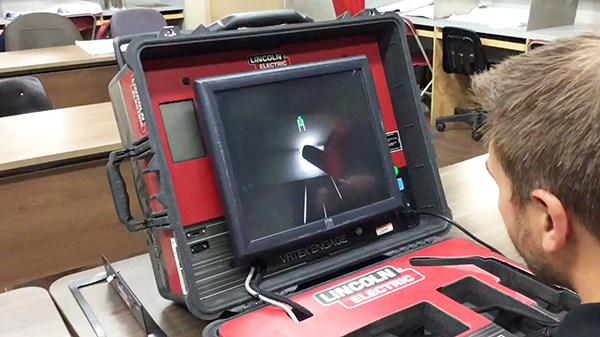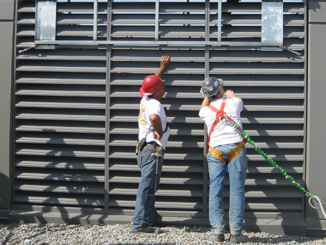
Industry bands together to address emerging technology trends.
By / Jessica Kirby • Photos courtesy of SMWTC
Reprinted with permission from the March 2020 issue of Partners in Progress. Visit pinp.org to subscribe and learn more about labour-management success.
The Sheet Metal Workers Training Center (SMWTC) has taken the leap into a technology-driven future with the support of SMACNA-BC’s contractor members. The centre participated in a project called, “Technology and an Inclusive Workforce: Forging our Future Sheet Metal Industry,” which was developed among industry partners including SMACNA, SMART, the ITI, and several others.
Funded through the government’s Union Training and Innovation Program (UTIP), this federal cost-sharing initiative was developed to improve the success of sheet metal workers using new equipment and to address emerging technology trends in the sheet metal industry.
“We have implemented several pieces of equipment and software that will help apprentices stay abreast of the latest offered in training and work and ensure they are prepared to help their contractor employers stay profitable and productive,” says SMWTC Training Co-ordinator, Jud Martell.
Through the program, SMWTCS apprentices and journeys will have access to and benefit from training on a mobile elevated work platform simulator, virtual reality/augmented welding technology, and fan service equipment for new a specialty training course.
The center’s welding equipment will also be upgraded to harmonize with technological changes to the welding process. Learning the equipment takes place using augmented reality in which the learning components are added to actual reality.
“When the user looks through the screen they can see the world,” says Martell. “When you turn on the machine, it adds the welding points, equipment, and materials to create welding situations in your real world.”
Martell says the UTIP project is a prime example of how the SMWTC is defining itself as a training center than embraces innovation.
“We are trying to look into the future and recognize how things will be done differently in the world moving forward,” Martell says. “This technology is a part of that. I can imagine sitting around in 20 years and being surprised about what we didn’t see coming. Maybe by that time you will go to work in a clean room with clean tools where you walk in and fire up your augmented space or your virtual tools to drive the robots that do the actual work,” he says.
Knowing and understanding the technology is a key part of staying ahead of changes in the future, he adds. “Ours has traditionally been a reactive industry. We’ve realized that if we don’t think about new technologies or solutions until the contractors mention it, then someone else is probably already doing it.”
Kevin Taylor, owner of City Sheet Metal in Vancouver, British Columbia, recognizes the ways technology continues to change the industry.
“From computer software, project managing programs, safety sites, equipment, advertising, and training, technology has increasingly become part of our business,” Taylor says. “Since taking over City Sheet Metal in 2008, we have incorporated all of the things listed above in order to stay competitive in a forever changing market.”
Competitiveness was the main reason City Sheet Metal has adopted new technology as needed, but these decisions were also made out of a keen understanding that failure to innovate means certain doom in the construction and any industry.
“It is easy to sit back and pat yourself on the back and think you are doing a great job,” Taylor says. “But if you are not thinking about the future and how you can improve your team for success you will quickly fall behind.”
The willingness and drive to be part of innovation in the industry is something that sets SMWTC apart, Martell says. “We can’t have contractors say, ‘we are thinking about this thing’ and say, ‘okay we will think about that later’,” he says. “Just look at the 80s when people were talking about computer-assisted drawing and manufacturing and people were saying, ‘That’s crazy talk. It’s never going to happen.’ Now, CAM and CAD are normal.”
He adds that anyone who didn’t take the evolution of computer-aided drawing seriously suddenly found themselves surprised and untrained because they didn’t get ahead of it.
“You have to get on board,” Martell says. “Some of the union people were the ones who failed to adopt, and you can actually track the rise in work for the non-union side to coincide with this time period. In the beginning, everyone also thought it was a crazy idea to put one trade into a training center and provide direct access and communication to the people building that trade, yet here we are.”
Of course, some firmly believe that implementing technology and automating certain job functions hurts the industry. Seeing the scenario as one where a machine is displacing a human being can make implementation a hard sell.
Taylor says technology is here to stay and firmly believes it doesn’t kill jobs but changes the way those jobs are completed.
“Technology is allowing us to complete jobs quicker, safer, and more profitably,” he says. “We are constantly looking for people to join the industry, and with man hours continuing to rise it is a hard argument to say that technology is killing jobs. It is, however, almost mandatory in order to get them done
on time.”
In the long run, it is up to contractors and the labor force to work together, evolve together, and approach the future of construction in a unified, open-minded way, Taylor says. As a board member at the Sheet Metal Training Center, Taylor feels it is essential and that the center is obligated as industry leaders to train apprentices on all the new technology available.
“The staff at the training center is constantly updating course content, adding new advanced training courses, and updating the equipment,” he says. “It now includes a virtual platform training lift along with the virtual welding machines. This will not only prepare our apprentices for the future; it may also attract the next generation to get into the trade.”
Martell agrees, saying the SMWTC and its contractor partners don’t just do work for today—they also work to build the resilience and critical thinking to apply skills to whatever is coming next.
“We are all it in together,” he says. “Partners are so important for building and maintaining our community. ■



